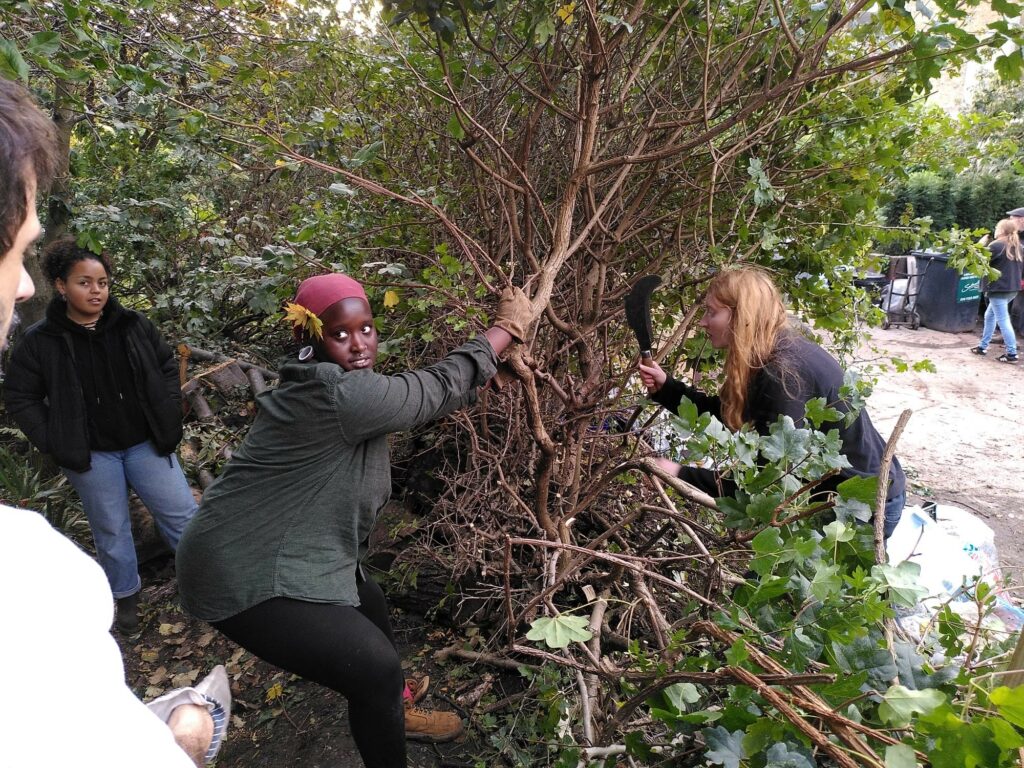By Danny Hubbard, Education Manager at Walworth Garden
Our Green London events aim to bring together people working across the city to make and keep it green, from guerrilla gardeners to tree growers. As part of this programme, this week Danny Hubbard from Walworth Garden in Kennington shares why he loves teaching at an inner-city community garden:
There is nothing quite like teaching gardening in London. In my life, I have tried teaching many different things, from sailing sessions on the Welsh Harp in Wembley to guitar lessons in people’s homes, and even found myself as a careers advisor in a Hackney secondary school for a short but intriguing spell. But gardening is something else. I hope you’ll agree with me by the end of this article that all of us, as urban gardeners, have a responsibility to ‘teach’, in our own small way, to make our towns and cities more fulfilling places to live.

In cities, gardens are immense reservoirs of possibility. Like subterranean lakes, green spaces can be obscured and neglected for years, lying dormant and untapped. But their transformation needs a catalyst: someone with a vision, or (cynically) gentrification and subsequent investment from the council or a housing developer. At Walworth Garden, a sequence of land grabs, swaps and community action days through the late 80’s and early 90’s led to its establishment as a community space. With over 80 adults now learning in the garden each week, we aim to give our students horticultural expertise, but also reverence for the precious green space that exists within a city.

We can’t be pure idealists when it comes to gardens. Green space, once its value is realised, is quickly subsumed into the pettiness of local politics, and we have to be prepared for this. And yet, we should not aim to be hard realists, either. Gardening should enable escapism – where else can we pursue paradise? – and it is both sides of the story that gardeners in London have a responsibility to tell.
To paint a true picture of gardening in London, we must face certain complexities. The vast majority of gardening in Zone 1 of London is done on patios, window-boxes and pots, from apartments to cafes and restaurants. A necessary part of my job, as a teacher of some of London’s new gardeners, is to provide this kind of reality-check: most of what you may end up doing is maintenance: rifling through fibreglass planters for cigarette butts (or worse), polishing leaves, and having a good old sweep up. Ornamental gardening in a city with high aesthetic standards is shockingly unsustainable: the ‘faux’ (read: plastic) plant industry is booming, pest management is generally still chemical, and we are importing vast quantities of peat-potted houseplants (these often come wrapped in single-use plastic). Don’t even get started on the embodied emissions and harm done by the aggregates industry. We also owe it to new gardeners to be transparent about the working conditions they should expect, from the cold winters to the trips to the dump, and generally poor pay.

Urban gardening should be a practice that encompasses all of these very real complexities. To teach gardening in a city, then, is to lead the way around the pitfalls of the industry at large. We should encourage new gardeners to learn to garden with rubble. We should prioritise year-round pollen and nectar supply for a wide range of pollinator mouth-parts. We must plant native hedges again, and make ponds. We must argue the benefits of mess. Above all, as the practice of gardening continues to evolve, we must be gardeners who can adapt and admit we were wrong, and have a thirst for getting to the root of the problem (pun intended).
To the garden I teach in, then. It is a small paradise; an oasis packed with examples of alternative gardening practices. Come and see it for yourself! No aesthetic is sacred, and every plant can be an opportunity to learn:

‘See these? Ilex crenata, Lonicera nitida and Euonymus ‘Green Spire’: alternatives to box’. Cue a discussion about pests and disease in London (alongside their treatment regimes); formality and evergreen structure, and care of topiary. These common structural plants have a colonial history that needs to be better known, too: the formal border was a vital component of Victorian ‘Plant Hunter’s’ gardens, whose ordered rows enforced Linnaean taxonomy onto often discordant plant collections from colonised nations.¹
‘This is one of our ponds (we have eight now!). Floating over there amongst those broken bricks is Salvinia natans.’ Another rabbit-hole: invasive species (and floating ferns), drinking water for invertebrates, and creative use of waste materials: carpet to bed pond-liners, washed building-waste for ‘rocks’, and rainwater to fill it in.

‘What about this? Salvia confertiflora: as it’s warm enough, we don’t need to overwinter any of our Salvias inside. We have about 10 further cultivars in the garden but this is my favourite’. Urban heat island effect, different flower-shapes (‘nectar-robbing’ by bumblebees!), and how to extend the flowering season.
A garden should be a place ready to burst with conversation. And, rising from all of this buzzing, feeding, life and death, the beauty of a garden makes us dream: new gardeners must experience this, and aspire to a higher ideal; to know that their city can be a better place.
—
Follow Walworth Garden on Instagram: @walworthgarden
See the range of courses on offer at Walworth Garden here.
[1] Patricia Fara, Sex, Botany and Empire, 2003
